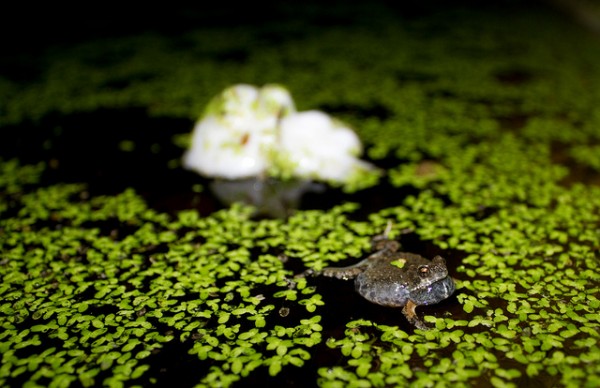For students aged 4 to 8
General objective: Learn that most amphibians live in two different environments their tadpoles are usually aquatic and adults are usually terrestrial.
Specific objective: Recognize the distinct phases of the life cycle of a tungara frog, and introduce students to the concept of metamorphosis.
Introduction

This male tungara frog is calling a female, a floating from nest containing eggs is floating in the puddle behind.
Look at the tungara frog reproduction exhibit at the Punta Culebra Nature Center, alternatively, find a roadside puddle with white foamy tungara frog nests on them and look for tadpoles. Most frogs reproduce by laying eggs, either in or near the water. Tungara frogs lay eggs in puddles and the males whisk the eggs into a white floating foam nest that can often be seen floating on puddles. The foam protects the eggs from drying out and from hungry predators. Once the tadpoles hatch they leave the foam mass and swim out to feed on algae and plant matter in the water. Tadpoles have gills for breathing and tails they use for swimming. At the end of the tadpole stage, a frog undergoes a process called metamorphosis in which its body makes a sudden transition into the adult form and they turn into froglets. The tadpole loses its gills for breathing in water and gains lungs for breathing in air. It also grows legs for walking on land. At the very end of the process it loses its tail, reabsorbing it into the body and the tadpole has finally turned into a frog! The froglets then leave the water and move to the land where they eat small insects and grow into adult frogs.
Activity: Frog life cycle
Tungara frog life cycle diagram cut out into the different life stages.
Procedure
• Present the subject of the amphibian life cycle using the diagram of the tungara frog life cycle.
• Ask the students where they think each stage occurs. For example: Where do frogs and toads lay their eggs? Why does a tadpole have a tail?
• Form groups of 3 to 5 students and give them life cycle worksheet. Ask them to form the life cycle with their cut-outs.
Adapting for other age groups
Discuss what other animals undergo metamorphosis. What changes in body type adapt them for the different life stages? Advanced students may want to research other types of amphibian reproductive modes. Compare the following species: Red eyed tree frog (Agalychnis callidryas) lay eggs on leaves, tadpoles drop into water below; Horned marsupial frogs (Gastrotheca cornuta) carry eggs in pouch on mother’s back; Rainforest rocket frog (Silverstoneia flotator) lays eggs in leaf litter, male transports tadpoles on back to the stream where they continue to develop; Strawberry poison dart frog (Oophaga pumilio) female carries tadpole to a water-filled tree hole and feeds them unfertilized eggs; Common rain frogs (Craugastor fitzingeri) lay eggs that hatch directly into frogs. What are the advantages of each reproductive strategy?
Scientists at the Panama Amphibian Rescue and Conservation Project try to breed endangered frogs in captivity. Studying the different kinds of amphibian reproduction and behavior is very important to help save these species! If we breed frogs for the first time in captivity those are known as first generation frogs (F1). If those frogs then have their own babies, they are called second generation frogs (F2). It is very important to get second generation frogs because it means that we have successfully completed a full frog life cycle in captive conditions from an egg all the way through to a new egg.


